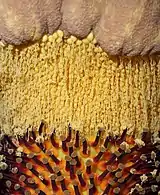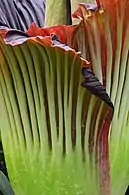Amorphophallus titanum
Amorphophallus titanum, the titan arum, is a flowering plant in the family Araceae. It has the largest unbranched inflorescence in the world. The inflorescence of the talipot palm, Corypha umbraculifera, is larger, but it is branched rather than unbranched. A. titanum is endemic to rainforests on the Indonesian island of Sumatra.
| Amorphophallus titanum | |
|---|---|
_-_2.jpg.webp) | |
| In bloom at New York Botanical Garden June 27, 2018 | |
| Scientific classification | |
| Kingdom: | Plantae |
| Clade: | Tracheophytes |
| Clade: | Angiosperms |
| Clade: | Monocots |
| Order: | Alismatales |
| Family: | Araceae |
| Genus: | Amorphophallus |
| Species: | A. titanum |
| Binomial name | |
| Amorphophallus titanum (Becc.) Becc. ex Arcang | |
| Synonyms | |
| |
Due to its odor, like that of a rotting corpse, the titan arum is characterized as a carrion flower, and is also known as the corpse flower or corpse plant as translated from the original Indonesian word bunga bangkai (bunga means flower, while bangkai can be translated as corpse, cadaver, or carrion).
The titan arum's berries arrange in a regular cylindrical form that resembles the packing of spheres inside a cylindrical confinement. Those structures are also called columnar structures or crystals.
Etymology
A. titanum derives its name from Ancient Greek (ἄμορφος amorphos, "without form, misshapen" + φαλλός phallos, "phallus", and Τιτάν Titan, "titan, giant").[2]
Description
_(Aracerae)_Titan_Arum_world_record_flower_2003_in_Botanical_Gardens_Bonn%252C_Foto_%C2%A9_W._Barthlott%252C_Bot.Gard._Bonn.jpg.webp)
Its corm is the largest known, typically weighing around 50 kg (110 lb).[3] When a specimen at the Princess of Wales Conservatory, Kew Gardens, was repotted after its dormant period, the weight was recorded as 91 kg (201 lb). [4] In 2006, a corm in the Botanical Garden of Bonn, Germany, was recorded at 117 kg (258 lb),[5] and an A. titanum grown in Gilford, New Hampshire by Dr. Louis Ricciardiello in 2010 weighed 138 kg (305 lb).[6][7] However, the current record is held by a corm grown at the Royal Botanic Garden Edinburgh, weighing 153.9 kg (339 lb) after 7 years' growth from an initial corm the size of an orange.[8] The tallest documented inflorescence was recorded at the Botanical Gardens Bonn (Germany) in May 2013 and reached 3.20 m.[9][10]
Flowers
.jpg.webp)
The titan arum's inflorescence can reach over 3 m (10 ft) in height.[11][9] Like the related cuckoo pint and calla lily, it consists of a fragrant spadix of flowers wrapped by a spathe, which looks like a large petal. In the case of the titan arum, the spathe is a deep green on the outside and dark burgundy red on the inside, with a deeply furrowed texture. The spadix is almost hollow and resembles a large baguette. Near the bottom of the spadix, hidden from view inside the sheath of the spathe, the spadix bears two rings of small flowers. The upper ring bears the male flowers, the lower ring is spangled with bright red-orange carpels. The odor ("fragrance") of the titan arum resembles rotting meat, attracting carrion-eating beetles and flesh flies (family Sarcophagidae) that pollinate it. The inflorescence's deep red color and texture contribute to the illusion that the spathe is a piece of meat. During bloom, the tip of the spadix is roughly human body temperature, which helps the perfume volatilize; this heat is also believed to assist in the illusion that attracts carcass-eating insects.[9]
Both male and female flowers grow in the same inflorescence. The female flowers open first, then a day or two following, the male flowers open. This usually prevents the flower from self-pollinating.
After the flower dies back, a single leaf, which reaches the size of a small tree, grows from the underground corm. The leaf grows on a somewhat green stalk that branches into three sections at the top, each containing many leaflets. The leaf structure can reach up to 6 m (20 ft) tall and 5 m (16 ft) across. The stalk, or petiole bearing the leaf can be up to 15-16 inches (38-41 centimeters) thick at soil level and still 12-13 inches (30-32 cm) at breast height (D.B.H.).[12] Each year, the old leaf dies and a new one grows in its place. When the corm has stored enough energy, it becomes dormant for about four months. Then the process repeats.
_Titan_Arum%252C_tuber_117_kg%252C_May_2006%252C_Foto_%C2%A9_W._Barthlott%252C_Bot.Gard._Bonn.jpg.webp)
Distribution
A. titanum is native solely to western Sumatra,[11] where it grows in openings in rainforests on limestone hills.[13] However, the plant is cultivated by botanical gardens and a few private collectors around the world.[11]
Cultivation
The titan arum grows in the wild only in the equatorial rainforests of Sumatra, Indonesia. It was first scientifically described in 1878 by Italian botanist Odoardo Beccari. The plant flowers only infrequently in the wild. It first flowered in cultivation at the Royal Botanic Gardens, Kew, London, UK, in 1889, with over 100 cultivated blossoms since then. The first documented flowerings in the United States were at the New York Botanical Garden in 1937 and 1939. This flowering also inspired the designation of the titan arum as the official flower of the Bronx in 1939, only to be replaced in 2000 by the day lily. In the Botanical Gardens of Bonn, the titan arum was cultivated since 1932 and the largest collection was built up by Wilhelm Barthlott after 1988, about 30 flowers were recorded and researched since.[10] The number of cultivated plants has increased in recent years, and not uncommonly five or more flowering events occur in gardens around the world in a single year, since today the cultivation requirements for gardens are known in detail.[14] Advanced pollination techniques mean that this plant is rarely cultivated by amateur gardeners. However, in 2011, Roseville High School (Roseville, California) became the first high school in the world to bring a titan arum to bloom.[15]
_Titan_Arum_Foto_%C2%A9_W._Barthlott%252C_Bot.Gard._Bonn.jpg.webp)
In May 2003, the tallest inflorescence in cultivation, some 3.20 m (10 ft 5 in) high (measured from its corm, 3.07 m from the soil surface), was grown at the Botanical Garden Bonn in Germany; this record was analyzed, photographed, and documented in detail.[16][10] The event was acknowledged by Guinness World Records.[17] The largest flower in the USA by Louis Ricciardiello, measured 3.10 m (10 ft 2 in) tall in 2010, when it was on display at Winnipesaukee Orchids in Gilford, New Hampshire, US. This event, too, was acknowledged by Guinness World Records.[18][19]
Blooming
In cultivation, the titan arum generally requires 5 through 10 years of vegetative growth before blooming for the first time. After a plant's initial blooming, there can be considerable variation in its blooming frequency. The cultivation conditions are known in detail.[14] Some plants may not bloom again for another 7 through 10 years while others may bloom every two or three years. At the botanical gardens Bonn, it was observed under optimal cultivation conditions that the plants flowered alternatively every second year.[11][10] A plant has also been flowering every second year (2012 to 2022) in the Copenhagen Botanical Garden.[20] Back-to-back blooms occurring within a year have been documented[21] and corms simultaneously sending up both a leaf (or two) and an inflorescence.[22] There has also been an occasion when a 117 kilograms (258 lb) corm produced three simultaneous blooms in Bonn, Germany.[16] [23] There was also a triplet bloom at the Chicago Botanic Gardens in May 2020 named "The Velvet Queen," but viewing was closed to the public due to COVID-19.[24]

The spathe generally begins to open between midafternoon[25] and late evening and remains open all night. At this time, the female flowers are receptive to pollination. Although most spathes begin to wilt within 12 hours, some have been known to remain open for 24 to 48 hours. As the spathe wilts, the female flowers lose receptivity to pollination.
Self-pollination was once considered impossible, but in 1992, botanists in Bonn hand-pollinated their plant with its own pollen from ground-up male flowers. The procedure was successful, resulting in fruit and hundreds of seeds from which numerous seedlings were eventually produced and distributed.[11][10][14] Additionally, a titan arum at Gustavus Adolphus College, in Minnesota, unexpectedly produced viable seed through self-pollination in 2011.[26]
Odor
As the spathe gradually opens, the spadix heats up to 37 °C (99 °F), and rhythmically releases powerful odors to attract pollinators, insects which feed on dead animals or lay their eggs in rotting meat.[16] The potency of the odor gradually increases from late evening until the middle of the night, when carrion beetles and flesh flies are active as pollinators, then tapers off towards morning.[27] Analyses of chemicals released by the spadix show the stench includes dimethyl trisulfide (like limburger cheese), dimethyl disulfide (garlic), trimethylamine (rotting fish), isovaleric acid (sweaty socks), benzyl alcohol (sweet floral scent), phenol (like Chloraseptic), and indole (like feces).[28][29]
Gallery
- Images of Amorphophallus titanum
 Two titan arum in Sumatra, Indonesia (ca. 1900–40); one in leaf, which can reach up to 6 m (20 ft) tall, and one in bloom
Two titan arum in Sumatra, Indonesia (ca. 1900–40); one in leaf, which can reach up to 6 m (20 ft) tall, and one in bloom Small corm of A. titanum, Muttart Conservatory, Edmonton, Canada
Small corm of A. titanum, Muttart Conservatory, Edmonton, Canada The pollen area as seen from the inside (UC Davis, California)
The pollen area as seen from the inside (UC Davis, California) Plant finishing blooming, showing the male and female flowers at the base of the spadix
Plant finishing blooming, showing the male and female flowers at the base of the spadix A. titanum close up, Bayreuth University, Germany, June 7, 2015
A. titanum close up, Bayreuth University, Germany, June 7, 2015 A. titanum close up, Bayreuth University, Germany, June 6, 2015
A. titanum close up, Bayreuth University, Germany, June 6, 2015 A. titanum close up, Bayreuth University, Germany, June 6, 2015
A. titanum close up, Bayreuth University, Germany, June 6, 2015 A. titanum leaflets, Muttart Conservatory, Edmonton, Canada
A. titanum leaflets, Muttart Conservatory, Edmonton, Canada A. titanum with fruits, Liberec, Czech Republic
A. titanum with fruits, Liberec, Czech Republic_Titan_Arum%252C_Foto_%C2%A9_W._Barthlott%252C_Bot.Gard._Bonn.jpg.webp) A. titanum view into the spathe with flowers on the basis of the spadix. Botanical Gardens Univ. Bonn 28. March 1997
A. titanum view into the spathe with flowers on the basis of the spadix. Botanical Gardens Univ. Bonn 28. March 1997_fruiting%252C_Foto_%C2%A9_W._Barthlott%252C_Bot.Gard._Bonn.jpg.webp) A. titanum fruiting at the Botanical Gardens Univ, Bonn in September 2009
A. titanum fruiting at the Botanical Gardens Univ, Bonn in September 2009 A. titanum young, just expanding single leaf in the Botanical Gardens Univ. Bonn, July 2009
A. titanum young, just expanding single leaf in the Botanical Gardens Univ. Bonn, July 2009 Amorphophallus titanum, world record flower 320 cm high, Botancial Gardens University of Bonn, 21-June-2013
Amorphophallus titanum, world record flower 320 cm high, Botancial Gardens University of Bonn, 21-June-2013
See also
References
- Yuzammi.; Hadiah, J.T. (2018). "Amorphophallus titanum". IUCN Red List of Threatened Species. 2018: e.T118042834A118043213. doi:10.2305/IUCN.UK.2018-2.RLTS.T118042834A118043213.en. Retrieved 1 May 2023.
- ἄμορφος, φαλλός, Τιτάν. Liddell, Henry George; Scott, Robert; A Greek–English Lexicon at the Perseus Project.
- Titan Arum in the, Botanical Gardens BonnArchived 2021-10-05 at the Wayback Machine
- Lobin, W., Neumann, M., Radscheit, M. & W. Barthlott (2007): The cultivation of Titan Arum (Amorphophallus titanum) – A flagship species for Botanic Gardens, Sibbaldia 5: 69–86
- "Titanenwurz – Bonner Blütenstände". 2013. Archived from the original on 2018-06-27. Retrieved 2013-06-23.
- Gilford Steamer (newspaper) July 1, 2010 pp. A1 & A9.
- "Tallest bloom".
- McDonald, Charlotte. "Royal Botanic Garden Edinburgh – The story of our corm". www.rbge.org.uk. Archived from the original on 2017-07-19. Retrieved 2017-07-14.
- Barthlott, W., Szarzynski, J., Vlek, P., Lobin, W., & N. Korotkova (2009): A torch in the rainforest: thermogenesis of the Titan arum (Amorphophallus titanum). Plant Biol. 11 (4): 499–505 doi:10.1111/j.1438-8677.2008.00147.x
- Titan Arum in the, Botanical Gardens Bonn Archived 2021-10-05 at the Wayback Machine
- Barthlott, W. & W. Lobin (Eds.) (1998): Amorphophallus titanum. – A Monograph, 226 pp, F. Steiner Verlag, Stuttgart (= Trop. subtrop. Pflanzenwelt Vol, 99, Acad. Science. Mainz). Download: (19,2 MB)
- Van Roy, Johan. "Stalk + Paksamuir". Retrieved May 8, 2013.
- University of Connecticut (14 Feb 2011). "Amorphophallus titanum". Archived from the original on 2012-05-02. Retrieved 17 February 2011.
- Lobin, W., Neumann, M., Radscheit, M. & W. Barthlott (2007): The cultivation of Titan Arum (Amorphophallus titanum) – A flagship species for Botanic Gardens, Sibbaldia 5: 69-86
- Gilford Steamer (newspaper) July 1, 2010 pp. A1 & A9
- Barthlott, W., Szarzynski, J., Vlek, P., Lobin, W., & N. Korotkova (2009): A torch in the rainforest: thermogenesis of the Titan arum (Amorphophallus titanum). Plant Biol. 11 (4): 499-505 [doi:10.1111/j.1438-8677.2008.00147.x]
- Botanic Garden of the University of Bonn. "Official Homepage of the Botanic Garden". Archived from the original on 28 January 2008. Retrieved 2008-02-08.
- Tallest bloom. Guinness World Records.
- Koziol, J. 2010. "Corpse flower" makes Guinness record Archived 2020-10-11 at the Wayback Machine. Fosters, September 24, 2010.
- Eastern Illinois University's Three Titan Arum Blooms 2012 Retrieved 2013-08-11
- 'Big Bucky' 5/2009 and 6/2009, University of Wisconsin–Madison
- 'Big Bucky' 5/2012 and 'Little Stinker' 9/2009, University of Wisconsin–Madison
- University of Bonn Botanic Garden, Bonn, Germany Three blooms from one corm Archived 2016-03-03 at the Wayback Machine Retrieved 2013-08-11
- "The Velvet Queen | Chicago Botanic Garden".
- Eastern Illinois University's Three Titan Arum blooms 2012. Retrieved 2013-08-11
- Gustavus Adolphus College Self-pollination 2011. Retrieved 2013-08-11
- "Titan Arum—FAQ | Chicago Botanic Garden". www.chicagobotanic.org. Retrieved 2015-10-01.
- American Chemical Society. The Chemistry of the Corpse Flower's Stench 2013
- Cornell University. What made 'Wee Stinky' stink. 2012. Retrieved 2013-08-11
Bibliography
- Barthlott, W. & W. Lobin (Eds.) (1998): Amorphophallus titanum – A Monograph. 226 pp, F. Steiner Verlag, Stuttgart (= Trop. subtrop. Pflanzenwelt 99, Akad. Science. Mainz).Download (19,2 MB)
- Barthlott, W., Szarzynski, J., Vlek, P., Lobin, W., & N. Korotkova (2009): A torch in the rainforest: thermogenesis of the Titan arum (Amorphophallus titanum). Plant Biol. 11 (4): 499–505 doi:10.1111/j.1438-8677.2008.00147.x
- Bown, Deni (2000). Aroids: Plants of the Arum Family. Timber Press. ISBN 0-88192-485-7
- Korotkova, N. & W. Barthlott (2009): On the thermogenesis of the Titan arum (Amorphophallus titanum). Plant Signaling & Behavior 4 (11): 1096–1098 doi:10.4161/psb.4.11.9872
- Lobin, W., Neumann, M., Radscheit, M. & W. Barthlott (2007): The cultivation of Titan Arum (Amorphophallus titanum) – A flagship species for Botanic Gardens, Sibbaldia 5: 69–86
- Association of Education and Research Greenhouse Newsletter, volume 15 number 1.
External links
- Three Webcams of Titan plus time-lapse videos at Gustavus Adolphus College in Saint Peter, Minnesota
- 3D Photo of 2004 bloom at Walt Disney World (Requires red/cyan 3D Glasses)
- List of bloomings in the US since 1937
- How to grow a Titan Arum
- Titan Arum at the Flower Park Kagoshima of Kagoshima Prefecture, Japan (in Japanese)
- Amorphophallus titanum YouTube video
